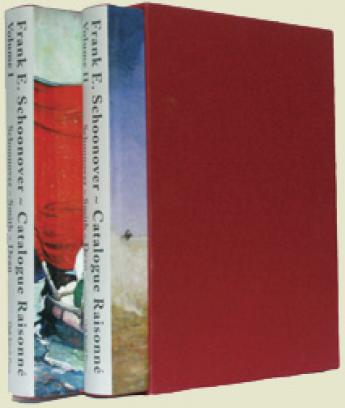Antiquarian Booksellers' Association of America Oak Knoll Books
Oak Knoll Press honours the life and work of a famous American Illustrator

Frank E. Schoonover Catalogue Raisonnée
Frank E. Schoonover (1877-1972) was one of the most important American illustrators of his time. In more than 40 years he created more than 2200 illustrations which were published in popular periodicals like Harpers, Scribner's, and Colliers, and in over 150 books, particularly children's classics and fiction by authors as Jack London or Edgar Rice Burroughs. His images of Hopalong Cassidy, Blackbeard, Jim Bridger, Robinson Crusoe, Abraham Lincoln, George Washington, and Joan of Arc remain a testimony of his artistic ability.
Schoonover was taught by the quintessential American illustrator, Howard Pyle, at Drexel Institute in Philadelphia and at Pyle's summer school in Chadds Ford. With Howard Pyle's help, Schoonover initiated his career in 1899 with four paintings for the book Jersey Boy in the Revolution. The Frank E. Schoonover Catalogue Raisonnée, published by Oak Knoll and announced in the Oak Knoll Biblio-Blog, gives an outline of Schoonover’s first experiences in studying art under the famous Howard Pyle:
In early September, 1896, an advertisement in the Philadelphia Inquirer forever changed his course. Listed in the newspaper was the fall offering of classes at Drexel Institute of Art, Science and Industry in Philadelphia. He scoured the ad and “…it said that anyone with a desire for illustration could have the instruction in that kind of art under the tutelage of Howard Pyle, that if the work in hand would pass the judgment of (great master to me) Howard Pyle. Well (and you can understand how this seemed to be an answer to it all) that was it.”
He confronted his parents. “I really think that I’m not really material or fitted to be a Presbyterian minister. I think I’d like to go down and study with Mr. Pyle and be an illustrator. They didn’t seem to object very much to it.” With the goal of eventually studying under Pyle, a hopeful Schoonover submitted drawings for admission to Drexel to Clifford P. Grayson, director of the School of Drawing, Painting, and Modeling in the Department of Fine and Applied Art. He was accepted into that four-year program at a time when Philadelphia provided a compelling environment for artists, educators, and those interested in the arts.
Significant among those in Philadelphia at the time was William Merritt Chase, who started teaching at the Pennsylvania Academy of the Fine Arts in 1896. William Glackens had returned to the city, Cecelia Beaux critiqued Academy portrait classes, and Thomas Anshutz taught its antique classes. Sculptor Charles Grafly instructed at Drexel and the Academy, and Howard Pyle was a luminary at Drexel. “The training provided in these surroundings was grounded in sound academic curricula with an evolving specialization in illustration.” Concurrently, the swift development of photoengraving throughout the country during the nineteenth century’s last quarter favorably advanced American illustration as an art form.
After Grayson’s favorable review, Schoonover was enrolled in Advanced Elementary Art, rather than the first class. The course involved drawing parts of the human figure, animals, and ornamentation from Drexel’s impressive collection of plaster casts. In February 1897, Schoonover progressed to Antique Art, a demanding class that required drawing the full-length figure from casts, clay modeling, still life painting in oil and watercolor, sketching, pen and ink rendering, and artistic anatomy. That year, Drexel’s Department of Domestic Science commissioned Schoonover’s first commercial art, The Cow, a large chart that diagramed cuts of beef. It hung at the Institute for many years.
Although he quickly advanced to drawing live models, he would not study under Pyle’s tutelage until he had successfully navigated three semesters of arduous classes. The principal requirement to enter Pyle’s class was to produce an original charcoal drawing, a medium with which Schoonover was quite comfortable. He offered Pyle several examples of his work: netting minnows, fishing, and exploring streams and bridges in Bushkill, all boyhood experiences he called “incidents.” “Mr. Pyle looked over them all and said because of the creative thought he would admit me…To hear on the day before Christmas that I had been admitted into Howard Pyle’s Class on Composition was my greatest Christmas present, as I felt I was on my way to some kind of living.”
In such proximity to so many promising young artists, Schoonover later recalled, “I felt about as big as a small piece of cheese.” Pyle, a large, imposing man who had cautioned his students never to be discouraged, intimidated new pupils by seating them at the rear of his classroom. Further, he selected only ten compositions a week for Friday afternoon critiques. Months passed and Schoonover’s efforts were rarely recognized. During this vexing time, he found an ally in Stanley Arthurs, another neophyte who sat next to him. Schoonover and Arthurs, later a noted painter of historical subjects, would become lifelong friends. Eventually, they found their place in Pyle’s class. “They took over the chores as class monitors, and as their talents developed the great teacher felt a fatherly concern for them. They were his favorites—helpers and friends until the end of his days.” Both Schoonover and Arthurs flourished in Pyle’s Life Studies class, and Schoonover’s work unerringly captured both feeling and movement, presaging his future illustrations that so aptly captured human emotion.
John Schoonover and Louise Schoonover Smith with Lee Ann Dean: Frank E. Schoonover Catalogue Raisonnée
2 volumes. New Castle, Delaware: Oak Knoll Press 2009. 846 pp. Hardcover with slipcase
Schoonover's entire oeuvre, from his earliest sketches to his last easel paintings, chronologically organized with the numeration based on his daybook entries. Included are over 3000 images, a detailed biography, information about Schoonover's models and students, lists of exhibitions and the magazines he illustrated. The pre-eminent record of Schoonover, his life, and his work.
>>> More about the book
>>> The Oak Knoll Biblio-Blog

